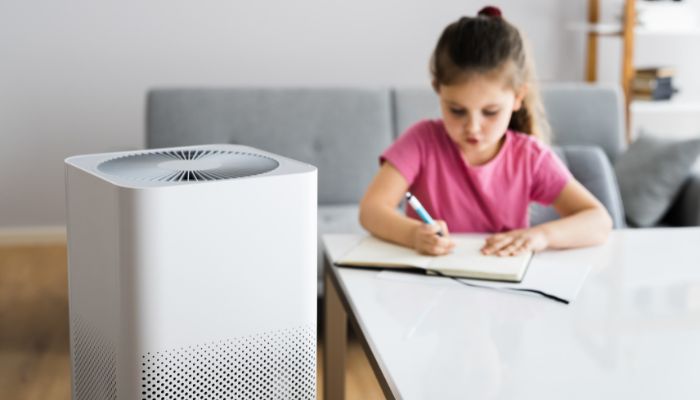
The best pure air purifier can remove particulate matter or gasses and chemicals, but each device is unique. Some purifiers feature a combination of filters to remove different pollutants. Other models target specific air pollutants. You can also find medical-grade purifiers with HEPA and activated carbon filters. Here’s an overview of four things a purifier removes from the air in your home:
1. Dust & Particulates
Air purifiers work by pulling indoor air through a filter to remove dust particles, pollutants, and allergens. Some filters have multiple layers, including a prefilter, high-efficiency particulate air (HEPA) filter, and carbon filter. Dust and other particulate matter won’t go beyond the prefilter. Top filters can trap ultra-fine sub-micron particles. The Environmental Protection Agency (EPA) states that HEPA filters can remove up to 99.97% of airborne particles measuring 0.3 microns or bigger.
The effectiveness of each purifier depends on its feature set and filters. Filters can be made using paper, fiberglass, mesh, foam, carbon, or aluminum. People with asthma and respiratory problems need purifiers with Allergy Standards Limited certification. Nearly all air purifiers can filter dust, which gets trapped in the prefilter. Some purifiers have washable prefilters, so you can reduce the buildup of dust and other particles. Choose purifiers with filters that cater to your needs.
2. Biological Pollutants
Air purifiers can help regulate and remove biological pollutants from your home. Popular biological pollutants include pet dander, dust mites, pollens, and mold spores. Use a pure air purifier with medical-grade HEPA filters to remove bacteria, viruses, and other transmitted biological pollutants. They may remove common biological pollutants that plague your home.
Biological pollutants can trigger asthma and various other respiratory problems. Protein in rat and mouse urine is a potent allergen that can dry and become airborne. Pollen from plants and viruses transmitted by people and animals can enter your indoor air. Contaminated central air handling systems also offer ideal breeding conditions for mold and mildew. The right air purifier filtration system should be able to remove biological pollutants, allergens, and sub-micron particles.
3. Chemicals and VOCs
Air purifiers can remove various chemicals and volatile organic compounds (VOCs). Activated carbon filters trap gas molecules, including smoke, road pollution, odors, and pesticides. If you use pesticides to control ants, termites, rodents, and microbes, air purifiers can help reduce exposure to such pollutants. Upgrade your filter to one rated to remove most chemical pollutants and VOCs. Carbon filters are also efficient in removing gases from pesticides and insecticides.
Exposure to chemicals and VOCs can result in various respiratory issues. Some building and home products release formaldehyde for months or years. Air purifiers can help keep the levels of such pollutants low to prevent health hazards. The best purifiers filter out a wide range of VOCs, including odors produced by paints, cleaning supplies, lacquers, and building materials. You can also use home office purifiers for VOCs from copiers, printers, correction fluids, glues, and permanent markers.
4. Tobacco Smoke and Smog
Toxins found in tobacco can linger in your home for several months after the smoker has left. Tobacco smoke is dangerous, as it contains harmful chemicals and carcinogens. Air purifiers may help remove smoke from the air you breathe. Smoke particles can be as small as 0.1 microns and measure up to 1.0 microns. You need activated carbon filters for such pollutants.
Choose models with a combination of HEPA and carbon filters. Find the right size air purifier and filters for your needs and increase the dwell time, which is the time air takes to pass through the filter. A longer dwell time can allow the carbon filter to trap more fumes and smoke. Use thicker carbon filters and replace them often to keep smoke and smog out of the air you breathe.
Go For a Pure Air Purifier
Investing in a pure air purifier can help you maintain the indoor air quality in your home. When purchasing a purifier, consider the filtration system, size, circulation speed, and other factors that affect efficiency. Choose products from leading non-toxic solutions companies. Choosing filters made from natural materials may improve the air quality in your home. Make sure you complete proper installation and replace filters on time for the best results.
Welcome to MithilaConnect, where we curate the art of living, celebrating the vibrant tapestry of life through culture, fashion, food, and everything in between.
